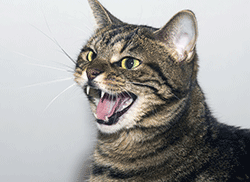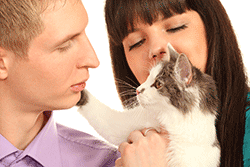General aggression in cats
If a cat is aggressive it is trying to tell you it is not comfortable with its situation - it is up to you to determine why

Hissing and growling cats
Cats naturally hiss and growl if they are uncomfortable with a situation, or feel under threat. In a well natured cat this is usually just a warning behaviour or an expression of discontent. It is often seen in trivial situations, for instance when a cat is moved from a comfortable resting place. In this type of situation, it is best to just move the cat quickly before it realises what has happened. The occasional grumble, meow, hiss, or growl is just part of normal communication.
If a cat is showing more aggressive behaviour, such as arching its back, leaning away from you, putting its hair on end or baring its teeth, then the situation is more serious and you are in danger of being attacked if you do not back away.
Is the behaviour normal or new?
If aggression shown by your cat is unusual behaviour it may be 'redirected aggression' from an unrelated incident such as a cat fight earlier in the day or something simple like being awoken too quickly, and the best solution is to simply leave your cat alone in the first instance. Cats often get into a heightened state of emotion, for instance if they have been watching birds out of the window, and if interrupted can lash out simply as a reflex response. These odd occasions of aggression are quite normal, but can surprise the owner.
If aggressive behaviour persists and is not a 'one-off' it is possible your cat is in distress or pain and should be taken to the vet. A general increase in aggression may be a sign of a developing medical condition such as arthritis, which can be quite painful, and may cause a cat to lash out.
Aggression in a new cat
Whilst cats are generally people friendly, a new cat, particularly an older cat, may take some time to adjust to new owners. If your cat is a 'problem' cat which has come from an unloving home, it will take some time to reverse its unfriendly behavioral traits. Almost all cats can be taught to re-trust another human but it will take time and patience. Spend lots of 'quiet time' with your cat, offering occasional treats as a reward and encourage some interactive play. When you see the first signs of aggression, never tell your cat off but instead simply back away and leave your cat alone. As trust develops aggressive behaviour should become less frequent until it is barely noticeable. If a cat has been aggressive for a long time, it will probably remain as a 'default' habit and may be prone to the odd swiping or hissing when it is caught by surprise or when unfamiliar people are around.
Aggression towards strangers

Your cat may need to be slowly introduced to new people
This is often a type of aggression known as 'fear aggression' and can be directed towards any kind of unfamiliar person, animal, or event. This can develop in cats who have not learnt to interact with other humans, or whose only contact with other humans is connected with bad experiences (going to the vet, cattery etc..) You can try and reduce the behavior by exposing your cat to different people in a safe environment. When your cat is calm and settled, have an unfamiliar person come and sit in the room, but at a good distance away from your cat. Providing your cat remains calm, offer a treat as a reward for good behaviour. Over time you can try closer meetings, with a treat each time for good behaviour. As soon as any aggression is shown, stop the meeting and give no treat, but don't punish either. The aim is to get your cat to associate other people being around with the good feeling of reward and treats.













